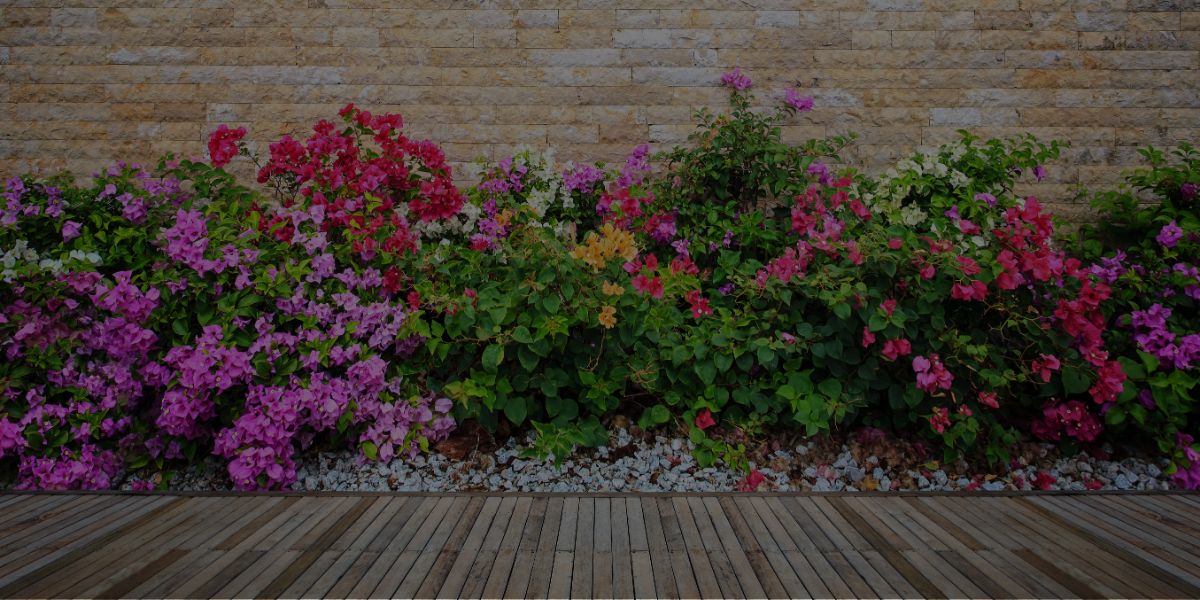If you’re a homeowner who’s looking to improve your backyard and boost your property value, or if you’re interested in becoming a professional landscape designer, then you’ve come to the right place! In this article, we’ll be covering a wide array of landscape design tips for beginners. Specifically, we’ll discuss everything from the basics of landscape design to more advanced concepts.
So, whether you’re a complete novice or just looking for some new ideas, read on for some helpful tips on how to create the perfect landscape!
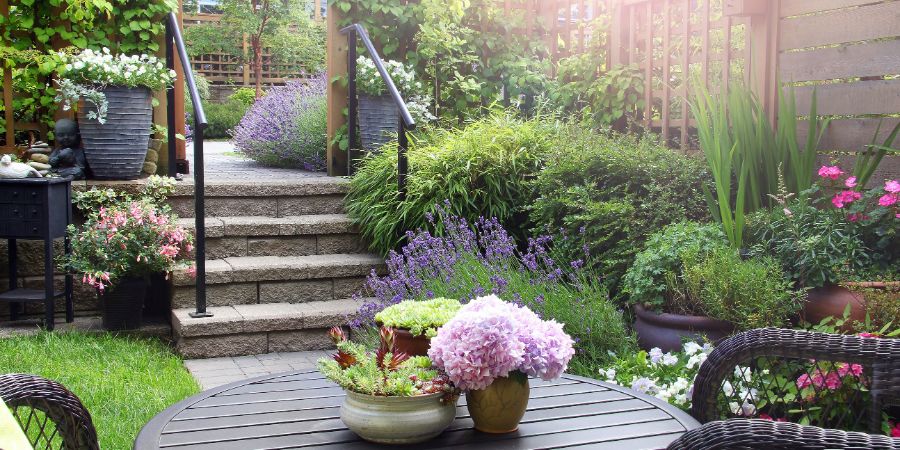
Landscape Design Tips: Getting Started
Tip #1: Create a Landscape Design Plan
The first step in any landscape design project is to create a plan. This plan will serve as your roadmap and will help you keep track of progress as you work. To create a plan, start by sketching out a rough idea of your property. Then, use graph paper to create a more detailed version of the design. Once you have a plan, you can begin to select the plants and other materials you’ll need to bring your vision to life.
Tip #2: Utilize Free Apps for Landscape Design
There are a number of free landscape design apps available that can help you plan and execute your project. These apps allow you to virtually design your landscape and provide helpful tips along the way. Some of our favorites include iScape, Landscaper’s Companion, and Garden Time Planner.
That said, if you have the budget for it, we also recommend checking out this list of the 5 best landscape design software out there (courtesy of The Spruce)!
Tip #3: Make Sure It’s a GOOD Landscape Design
While it’s important to have a plan, it’s even more important to make sure that your plan is good. To do this, consider the following factors:
- The function of the space: What do you want your landscape to do? Do you want it to provide privacy, create a focal point, or simply add curb appeal?
- The size of the space: How big is your property? This will help you determine how many plants and other materials you’ll need.
- The existing features: What features already exist on your property? This includes things like trees, fences, and walkways. You’ll want to take these into account when planning your design so that you can work around them.
- The climate: What is the climate like in your area? This will help you select plants that are well-suited to your specific location.
Interested in a profitable career as a landscape designer? Discover how you can start your very own business as in as little as 3 months!
15 Landscape Design Tips For Beginners
Tip #1: Consider the Function of the Space
When planning your landscape, it’s important to consider what you want it to do. Do you need privacy? Are you looking to add curb appeal? Knowing the function of the space will help you select the right plants and materials.
Tip #2: Get Creative With Your Curb Appeal
There are a number of ways to add curb appeal to your home. From planting flowers to adding landscape lighting, there are endless possibilities. So, get creative and experiment until you find the perfect solution for your home!
Tip #3: Plant Trees For Privacy
If you’re in need of privacy, consider planting trees. Evergreens are a great option as they provide year-round coverage. Just be sure to plant them far enough away from your house so that their roots don’t damage your foundation.
Similarly, make sure you know what the rules and regulations are for tree planting in your area. Some cities have strict regulations about what types of trees can be planted and where they can be planted.
Tip #4: Use Landscape Lighting
Landscape lighting is a great way to add interest to your yard. It can also be used to highlight specific features or create a focal point. When selecting landscape lights, be sure to choose ones that are energy-efficient and durable. We’ll provide some more tips for lighting later!
Tip #5: Create a Focal Point
A focal point is an important element in any landscape design. It’s typically something that catches the eye and draws attention to the area. To create a focal point, you can use a variety of features such as plants, sculptures, or water features.

Tip #6: Incorporate Water Features
Water features are a great way to add interest and relaxation to your landscape. From ponds to fountains, there are many different options to choose from. Just be sure to select a water feature that is appropriate for the size of your yard.
Tip #7: Use Native Plants
When selecting plants for your landscape, be sure to choose ones that are native to your area. This will help them thrive in your climate and save you money on watering and maintenance. If you’re not sure how to find plants native to your area, this article by Native Backyards will help you get started!
Tip #8: Install a Patio or Deck
A patio or deck is a great way to extend your living space outdoors. It’s also a great spot for entertaining guests or relaxing after a long day. When selecting materials, be sure to choose ones that are durable and easy to maintain.
Tip #9: Add Flower Beds
Flower beds are a great way to add color and texture to your landscape. They can also be used to create privacy or define boundaries. When choosing plants, be sure to select ones that are appropriate for the size of your bed and the amount of sunlight it receives.
Tip #10: Use Landscape Edging
Landscape edging is a great way to define different areas of your yard. It can also be used to create visual interest or accentuate certain features. When choosing landscape edging, be sure to select materials that are durable and easy to maintain.
Tip #11: Install a Garden Shed
A garden shed is a great way to add storage space to your landscape. It’s also a nice spot to take refuge from the sun or enjoy some peace and quiet. When selecting a shed, be sure to choose one that is made from durable materials and is appropriate for the size of your yard.
Tip #12: Plant Shrubs and Bushes
Shrubs and bushes are a great way to add privacy to your landscape. They can also be used to create boundaries or define different areas of your yard. When choosing plants, be sure to select ones that are appropriate for the size of your space and the amount of sunlight it receives.
Tip #13: Install a Fence
A fence is a great way to provide privacy and security to your landscape. It can also be used to define boundaries or accentuate certain features. When choosing a fence, be sure to select materials that are durable and easy to maintain.
Tip #14: Add Landscape Mulch
Mulch is a great way to protect your plants and help them retain moisture. It can also be used to improve the appearance of your landscape by adding color and texture. When choosing mulch, be sure to select a type that is appropriate for your climate and the plants in your landscape.
Tip #15: Hire a Professional Landscape Designer
If you’re not sure where to start with your landscape design, consider hiring a professional. A landscape designer can help you create a plan that fits your needs and budget. Furthermore, they can also provide guidance and advice on selecting the right plants and materials for your landscape.
PRO TIP: Alternately, you can become a landscape designer yourself in as little as 12 short weeks – even if you don’t have any experience!
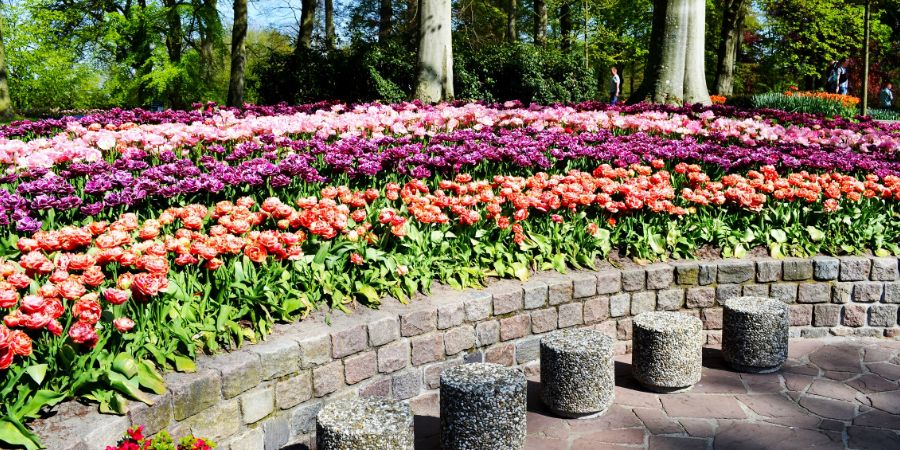
5 Landscape Lighting Tips for Your Outdoor Design
Lighting is an important aspect of landscape design. It can be used to accentuate certain features, create a sense of drama, or simply provide illumination for evening activities. When selecting lighting for your landscape, be sure to choose fixtures that are durable and easy to maintain. Furthermore, you’ll want to select bulbs that are appropriate for the type of fixture and the amount of light required.
Let’s take a look at 5 tips for landscape design lighting that’ll come in handy for you…
Tip #1: Use Path Lights to Illuminate Walkways
Path lights are a great way to provide illumination for walkways, steps, and other areas of your landscape. To install these types of lights, simply place them along the edges of the path.
Importantly, when choosing path lights, be sure to select fixtures that are durable and easy to maintain. Furthermore, you’ll want to select bulbs that are appropriate for the type of fixture and the amount of light required.
(These last two point can – and should – be applied to EVERY lighting tips discussed, by the way!)
Tip #2: Use Flood Lights to Highlight Landscape Features
Flood lights are a great way to highlight landscape features such as trees, sculptures, or water features. To install them, simply place them in the ground and angle them towards the feature you wish to highlight.
Tip #3: Use Spot Lights to Accentuate Architectural Elements
Spotlights are a great way to accentuate architectural elements such as columns, arches, or fountains. To install spot lights, you’ll want to place them in the ground and aim them towards the element you wish to highlight.
Tip #4: Use Under-Cabinet Lights to Brighten Countertops
Under-cabinet lights are a great way to brighten countertops, shelves, or other areas of your landscape. To install these types of lights, start by placing them under the cabinets or shelves. Then, aim the lights towards the area you wish to illuminate.
Tip #5: Use Solar Lights to Save Energy
Solar lights are a great way to save energy and money on your landscape lighting. They’re also easy to install and require little maintenance. To install solar lights, simply place them in the ground and allow them to charge during the day. Then, they’ll automatically turn on at night and provide illumination for your landscape design!
10 Basic Landscape Design Tips for Decor
Next, we’ll take a look at some basic landscape design tips for decor. Landscape decor can be used to add interest, create a focal point, or simply provide a place to relax. When selecting decor for your landscape, be sure to choose items that are appropriate for your climate and the plants in your landscape.
Tip #1: Use Planters to Add Color and Interest
Planters are a great way to add color and interest to your landscape. Depending on the season, you may want to switch up the plants in your planters to keep them looking fresh. For instance, in the summer, you may want to use annuals such as impatiens or petunias. But in the winter, you may want to switch to evergreens such as holly or boxwood.
Tip #2: Use Statues or Sculptures to Create a Focal Point
Statues or sculptures are a great way to create a focal point in your landscape. What’s fun about this option is that the type of statue(s) or sculpture(s) you choose are entirely up to you! For example, you could pick from any of the following:
- Animals
- Birds
- Butterflies
- Flowers
- Trees
- People
The possibilities are endless! Just be sure to choose a statue or sculpture that complements the other elements in your landscape. From there, and in order to maximize the use of statues or sculptures, we recommend placing them in the center of your landscape (or in an area where they’ll be most visible).
Tip #3: Use Benches to Create a Place to Relax
Benches are a great way to create a place to relax in your landscape. Not to mention, you can strategically select benches that are aesthetically pleasing and complement the look and feel of the rest of your outdoor design! From there, all you need to do is place them in an area where you would like to sit and enjoy the view.
Tip #4: Use Garden Lights to Add Drama and Ambiance
Garden lights are a great way to add drama and ambiance to your landscape. For different types of lighting, refer to our list of lighting tips discussed earlier!
Tip #5: Use Outdoor Furniture to Create a Living Space
Outdoor furniture is a great way to create a living space in your landscape. For example, you could include literally any of the following types of furniture into your outdoor design:
- Benches
- Chairs
- Tables
- Sofas
- Hammocks
- And much more!
The options are endless. Again, though, just be sure to choose furniture that’s appropriate for your climate and the plants in your landscape.
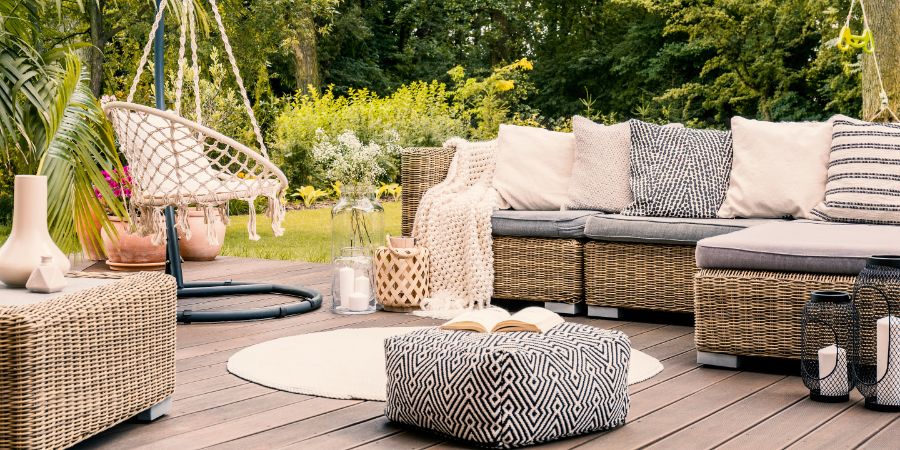
Tip #6: Use Area Rugs to Define Outdoor Spaces
Area rugs are a great way to define outdoor spaces in your landscape. Since you can purchase them in countless different sizes, colors, and designs, they make it easy to achieve any look or feel you’re going for! Just be sure to choose an area rug that’s durable and can withstand the elements.
Tip #7: Use Container Gardens to Add Interest
Container gardens are a great way to add interest to your landscape. In a nutshell, these are simply gardens that are planted in containers (i.e. pots, planters, etc.). The great thing about container gardens is that they can be placed just about anywhere! For example, you could put them on your patio, by your front door, or even in the middle of your lawn.
Tip #8: Use Window Boxes to Add Curb Appeal
Window boxes are a great way to add curb appeal to your landscape. Window boxes refer to any type of box that’s placed beneath a window (usually for the purpose of holding plants). But regardless of where you place them, window boxes are an easy and effective way to add a pop of color and interest to your landscape!
Tip #9: Use Fountains or Waterfalls to Create a Relaxing Atmosphere
Fountains and waterfalls are a great way to create a relaxing atmosphere in your landscape. The sound of running water is incredibly soothing and can help to mask any unwanted noise from the outside world. Plus, fountains and waterfalls come in all sorts of different sizes. Thus, you’re sure to find one that’s perfect for your landscape!
Tip #10: Use Paths to Direct Foot Traffic
Paths are a great way to direct foot traffic in your landscape. Moreover, they can be used to create different “zones” or areas in your landscape. For example, you could use a path to create a separation between your garden and your lawn. Or, you could use a path to lead guests from your front door to your back patio.
The possibilities are endless! Plus, you can also add a little personalization to them by using different materials, such as pavers, stones, or gravel!
15 Advanced Landscape Design Tips & Tricks
Now that we’ve covered all of the basics, it’s time to move on to some more advanced landscape design tips and tricks!
Tip #1: Incorporate Different Textures
One easy way to add interest to your landscape is to incorporate different textures. For example, you could use a combination of smooth stones, rough bark, and fluffy moss. By doing so, you’ll create a landscape that’s both visually and tactilely stimulating!
Tip #2: Use Contrasting Colors
Another great way to add interest to your landscape is to use contrasting colors. For example, you could pair together light-colored stones with dark-colored mulch. Or, you could use bright-colored flowers against a backdrop of green foliage. By doing so, you’ll create a landscape that’s both visually and emotionally stimulating!
PRO TIP: Become a master of color with the help of QC Design School‘s self-paced, online Color Consultant Course!
Tip #3: Use Different Sizes
Yet another great way to add interest to your landscape is to use different sizes. For example, you could use large stones in combination with small pebbles. Or, you could use tall trees in combination with short shrubs. By doing so, you’ll create a landscape that’s both visually and physically stimulating!
Tip #4: Know How To Draw Floorplans
If you’re serious about landscape design, then it’s important to know how to draw floorplans. This will allow you to create a blueprint of your landscape so that you can make sure everything is in the right place before you start planting!
FUN FACT: QC’s online Interior Decorating Course will teach you how to draw floorplans from scratch – as well as teach you everything you need to become a certified International Design and Decorating Professional (IDDP)!
Tip #5: Use The Golden Ratio
The Golden Ratio is a mathematical formula that’s often used by landscape designers. To sum it up, the Golden Ratio states that certain proportions are more aesthetically pleasing than others. So, if you want to create a landscape that’s truly stunning, then make sure to incorporate the Golden Ratio!
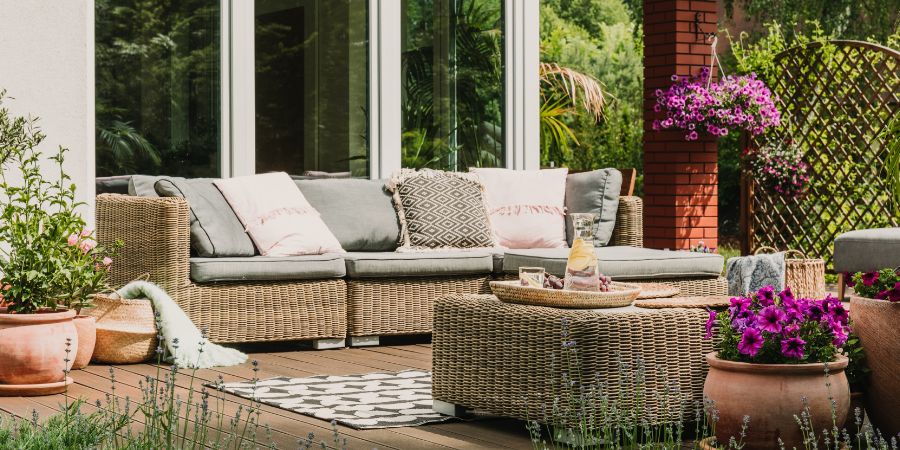
Tip #6: Refer to The Feng Shui Bagua Map
The Feng Shui Bagua Map is a Chinese map that’s used to determine the best placement of objects in a given space. This map can be incredibly helpful when you’re trying to decide where to place certain features in your landscape. So, if you want to take that extra step, be sure to consult the Feng Shui Bagua Map!
Tip #7: Consider The Five Elements
While on the topic of Feng Shui, another helpful tip to keep in mind when designing your landscape is to consider the five elements. These five elements are wood, fire, earth, metal, and water. Each element has its own unique properties that can help to create a balanced landscape.
PRO TIP: Become a fully trained Advanced Feng Shui Design Professional (AFDP) in just 3-6 months by enrolling in QC Design School’s online Feng Shui Design Course today!
Tip #8: Use Curves
While straight lines are often used in landscape design, curves can actually be incredibly helpful in creating a more organic feel. Plus, they can help to make a space feel more open and inviting. So, if you want your landscape to have a more natural look, be sure to incorporate some curves!
Tip #9: Consider Softscape vs. Hardscape
When you’re designing your landscape, it’s important to consider the difference between softscape and hardscape. Softscape refers to the living elements of your landscape, such as plants, trees, and shrubs. Hardscape refers to the non-living elements of your landscape, such as pavers, stones, and gravel. By considering both softscape and hardscape, you’ll be able to create a more balanced landscape!
Tip #10: Keep Spatial Planning in Mind
When you’re designing your landscape, it’s important to keep spatial planning in mind. This simply means that you should think about how each element will occupy space. For example, you’ll need to consider the size of your plants, the placement of your pavers, and the layout of your garden beds. By keeping spatial planning in mind, you’ll be able to create a more efficient and effective landscape!
Tip #11: Know Your Plants and Their Physiology
If you want to create a beautiful landscape, then it’s important to know your plants and their physiology. For example, you should know how much sun and water each plant needs. You should also be aware of the plant’s growth rate and mature size. By knowing these things, you’ll be able to choose the right plants for your landscape!
Tip #12: Learn About The Principles and Elements of Design
In the world of home and landscape design alike, there are certain principles and elements that are applicable to EVERY aspect of design. These are:
Principles:
- Balance – This principle refers to the distribution of visual weight within a given space. You can create balance in your landscape by using a variety of elements, such as plants, trees, sculptures, etc.
- Proportion and Scale – This principle refers to the relationship between the different elements in your landscape. For example, you wouldn’t want to use very large plants in a small space. Instead, you would want to use plants that are proportional to the size of the space.
- Contrast – This principle refers to the differences between the elements in your landscape. You can create contrast by using different colors, textures, and sizes of plants.
- Emphasis – This principle refers to the focal point of your landscape. You can create emphasis in your landscape by using a variety of elements, such as color, texture, and scale.
- Rhythm – This principle refers to the repetition of elements in your landscape. You can create rhythm in your landscape by using a variety of elements, such as color, texture, and scale.
- Unity and Harmony – This principle refers to the overall cohesiveness of your landscape design. You can create unity and harmony in your landscape by using a consistent color scheme and/or style.
Elements:
- Color – This element refers to the different colors used in your landscape. You can use color to create contrast, emphasis, and rhythm in your landscape.
- Form – This element refers to the different shapes used in your landscape. You can use form to create balance, contrast, and emphasis in your landscape.
- Line – This element refers to the different lines used in your landscape. You can use line to create contrast, emphasis, and rhythm in your landscape.
- Shape – This element refers to the different shapes used in your landscape. You can use shape to create balance, contrast, and emphasis in your landscape.
- Texture – This element refers to the different textures used in your landscape. You can use texture to create contrast, emphasis, and rhythm in your landscape.
- Space – This element refers to the different areas used in your landscape. You can use space to create balance, proportion and scale, and unity and harmony in your landscape.
By understanding and applying these principles and elements, you’ll be able to create a more successful landscape!
Tip #13: Plan for Equipment Access and Storage
If you’re going to be doing any landscaping, then it’s important to plan for equipment access and storage. This is especially true if you have a small yard. You’ll need to make sure that you have enough space to store your equipment, as well as enough room to maneuver it around in your yard. By planning ahead, you’ll be able to avoid any headaches down the road!
Tip #14: Create Visual Movement in Your Landscape
Movement is an important element of landscape design. This is because it can help to create a sense of flow and continuity in your design. You can create movement in your landscape by using a variety of elements, such as color, texture, and line. By creating movement, you’ll be able to add interest and depth to your outdoor space!
Tip #15: Remember To Accent Your House
Last but not least, your landscape should complement your house, not compete with it! This is why it’s important to remember to accent your house when you’re designing your landscape. You can do this by using a variety of elements, such as color, texture, and line. By accenting your house, you’ll be able to create a more unified and cohesive design.
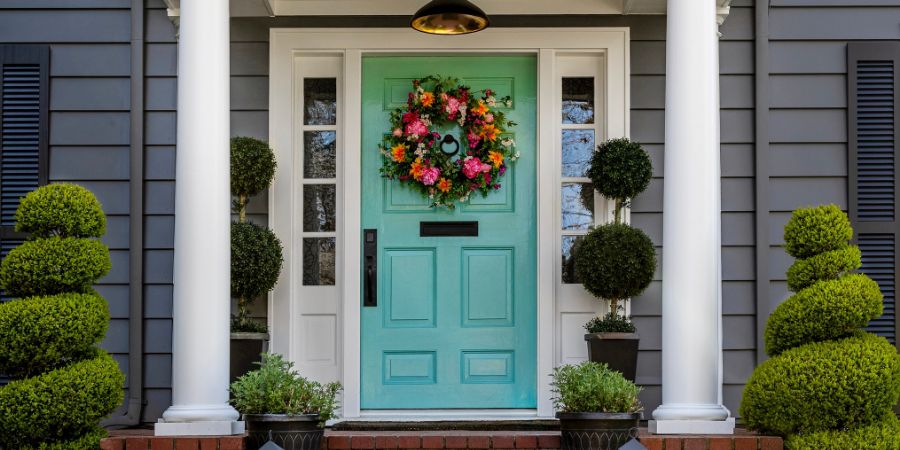
Tips On Landscape Design: Conclusion
Landscape design is a great way to improve the look of your outdoor space. By following these tips, you’ll be well on your way to creating a beautiful landscape that you can enjoy for years to come!
And if you’re interested in becoming a professional landscape designer, we recommend checking out QC Design School’s self-paced, online Landscape Design Course! In as little as 12 short weeks, you’ll learn everything you need to know to become a globally-certified International Landscape Design Professional (ILDP)!
Got any questions, comments, or tips to add?
Drop them down below. We always love hearing from you!
Thanks so much for reading… And happy designing! 🙂

